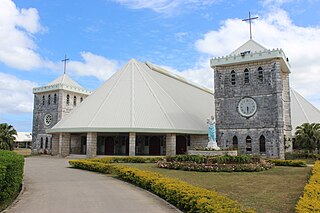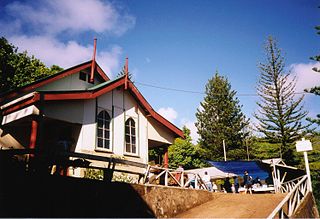
Mata Utu is the capital city of Wallis and Futuna, an overseas collectivity of France. It is located on the island of Uvéa (ʻUvea), in the district of Hahake, of which it is also the capital. It is one of two ports in Wallis and Futuna, the other being at Leava on Futuna. Hihifo Airport, the main airport serving the island and city, is 5.6 kilometres (3.5 mi) to the northwest. Its population was 1,029 in 2018, up from 815 in 1998.

Cathedral of Our Lady of the Assumption, also known as Matâ'Utu Cathedral, is a Roman Catholic cathedral, and a national monument of France, located in the town of Mata Utu on Uvea, in Wallis and Futuna. It is a dominant edifice in downtown Mata-Utu town, capital of Wallis Island. It bears the royal insignia of Wallis, a Maltese cross between its towers. The cathedral is also known as the "Our Lady of Good Hope Cathedral". It is the seat of Bishop Susitino Sionepoe.

Notre Dame Cathedral is a 20th-century church that serves as the cathedral of the Roman Catholic Diocese of Taiohae or Tefenuaenata. It is located in the Meau Valley near the capital centre on the island of Nuku Hiva.

Lake Lalolalo is a volcanic crater lake surrounded by jungle to the southwest of the island of Wallis (Uvea) in the Pacific Ocean. The largest lake on the island, it lies off Route 1 between the coastal village of Mala'etoli and Ahoa. A small lake, Lake Lano, lies just to the northwest.

The Cathedral of St. Mary is a religious building located on Vuna Road in the town of Nukualofa, capital of the Kingdom of Tonga a small independent state in Oceania. It should not be confused with the Basilica of Saint Anthony of Padua also located in the same city.

Alega is a village on the southeast coast of Tutuila Island, American Samoa. One of the island's least populous villages, it is located to the east of Pago Pago Harbor and to the west of Faga'itua Bay. Alega, with a population of 29 according to the 2020 U.S. Census, is one of the smallest villages in American Samoa, surpassing only Maloata and Sili in population.
Netball in Niue is a popular local sport. Games are most often played by girls on Saturdays between June and August, though games can be played at all times of the year. Most of the netball is played on high school athletic grounds.
Down Rope is a coastal area on the southeast coast of Pitcairn Island in the south Pacific, to the east of the Aute Valley and north of Break Jim Hip, it lies on the eastern side of an inlet and contains large petroglyphs on the rock face, testament to the Polynesian settlers of centuries ago. It is described as "a steep cliff located on the southern coast south of Ned Young's Ground, and west of St Paul's Point. At its foot, despite its perilous descent, is a popular picnic area and Pitcairn's only beach." The descent from the cliff top is said to be "spine chilling". There is anchorage at Down Rope and ignimbrite is also found in the vicinity.

The Sacred Heart Church, also known as the Church of the Sacred Heart or Sacred Heart Catholic Church, is a Roman Catholic church on the Fijian island of Ovalau, situated on Beach Street in the town of Levuka. The church's clock tower serves as a lighthouse to guide the ships to the port through an opening in the reef. The church is part of the heritage status accorded to Levuka by its inscription as a World Heritage Site by UNESCO.

Pélé Island, sometimes spelled Pele in English, is a volcanic island located 11,2 miles north of the island of Éfaté in the Shefa Province of the Republic of Vanuatu. It has a total area of 1.7 square miles, Pélé is inhabited by about 200-220 Ni-Vanuatu villagers residing in the four villages: Worsiviu, Worearu, Piliura, and Launamoa. Pélé Island is a part of the MPA Nguna-Pele Marine Protected Area, which was established in 2003, and is a popular Vanuatuan diving location. The Nguna-Pele Marine Protected Area covers a total area of 11.5 sq. mi., including numerous reefs, sea grass beds, mangrove forests and intertidal lagoons. The Nguna-Pele Marine Protection Agency is located in the village of Piliura, and mounts an exhibition and sells T-shirts. Income from tourism is distributed by the Village Tourism Committee and supports aims as village water supply projects. The island can be visited daily by boat from the Paonangisu area by the town of Emua on Éfaté's north coast. There are also yachts available both from Emua and Nguna for day and overnight charters to the island. The island is nearly adjacent to the island of Nguna, with a small passage no deeper than 33 yards separating the two. It has a tropical climate and has a maximum elevation of 650 feet at its highest. Much of the island is extremely steep and rocks prevent you from walking along the coastline around the island. White sandy beaches are found in Piliura, Worearu, Laonamoa, and Sake. Overpopulation has led to a steady migration from Pele villages to southern Nguna in recent times.
Hitikau is a volcanic mountain of Ua Huka, in the Marquesas Islands of Polynesia. It has an elevation of 884 metres (2,900 ft), the highest point of the island, and lies to the northeast of the village of Hane.

The Jean P. Haydon Museum is a museum in Pago Pago dedicated to the culture and history of the United States territory of American Samoa. It contains a collection of canoes, coconut-shell combs, pigs’ tusk armlets and native pharmacopoeia. It also houses exhibits on natural history, tapa making, traditional tattooing, as well as a collection of war clubs, kava bowls, and historic photographs. Constructed in 1913 as U.S. Naval Station Tutuila Commissary, the building was home to Tutuila Island's Post Office from 1950 to 1971. The museum has displays of various aspects of the Samoan Islands’ culture and history. It is the official repository for collections of artifacts for American Samoa. Funded by the American Samoa Council on Arts, Culture and the Humanities, it is the venue used for numerous of the cultural resource activities in American Samoa.
The Basilica of St. Anthony of Padua or simply Church of St. Anthony of Padua, is a Catholic church in the Taufa'ahau road in the town of Nukualofa, the capital of the Kingdom of Tonga in the Pacific Ocean.

The Adamstown Church, or alternatively Adamstown Adventist Church, is a religious building affiliated with the Seventh-day Adventist Church, located in the town of Adamstown in the Pitcairn Islands, a dependent territory of the United Kingdom in Oceania, at an isolated end of the Pacific Ocean.
Tula is a village in the Eastern District of Tutuila Island in American Samoa. Tula is located in Vaifanua County and had a population of 405 as of the 2010 U.S. Census.
Fagatogo Market is a market centred in the Fagatogo area of Pago Pago, the capital of American Samoa. It opened in 2010 for farmers and fishermen to sell fruits, vegetables and fish. Souvenirs are sold among live entertainment here when cruise ships are in town. It lies in front of Pago Pago's main bus terminal. Nearby are Fagatogo Square Shopping Mall. Mount 'Alava, the canneries in Atu'u, Rainmaker Mountain and Pago Pago Harbor.
Feleti Barstow Public Library is the main library in American Samoa, and is located in the village of Utulei in Maoputasi County. It is the central public library for the territory and is situated immediately across from the Office of Tourism, next to the Executive Office Building, and just behind Samoana High School. Besides a permanent display depicting American Samoa’s involvement in the Apollo Space Program, the library has also worked with the American Samoa Historic Preservation Office (ASHPO) since 2000 at creating a historic Polynesian Photo Archive. The goal of the project has been to electronically catalog and archive around 6,000 still and moving images of Polynesia which were collected by the American Samoa Government. The library has an extensive Pacific Collection which houses articles, books, and reports relevant to Pacific- and Samoan history. A large collection of photographs are stored in its Polynesian Photo Archive, which is a subset of their Pacific Collection.
Ottoville is a subdivision or district within the village of Tafuna, American Samoa.
Amalau is the name of a valley and a bay within the National Park of American Samoa. Amalau Valley is located between Vatia and Afono, and it is an isolated valley with various wildlife such as large numbers of native bird species and flying fox megabats. Amalau Valley is reached on the road leading to Vatia. There are only a few homes at Amalau.
Tia Seu Lupe is a historical site at Fatuoaiga, American Samoa, which is maintained by the American Samoa Department of Parks and Recreation. The Tia Seu Lupe Historic Monument was dedicated by Governor Peter Tali Coleman in May 1990. It is located on a 0.2 ha plot of land on the Tafuna Plain which has been leased by the Government of American Samoa. The monument exhibits a stone structure which archeologists believe were platforms constructed for the chiefly sport of pigeon catching. The name "Tia Seu Lupe" literally means "earthen mound to catch pigeons".










